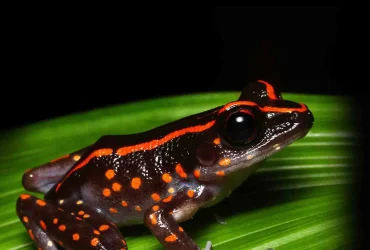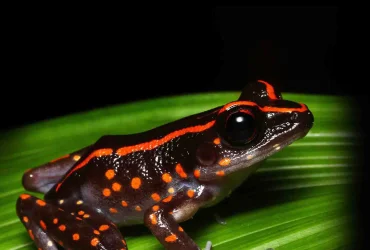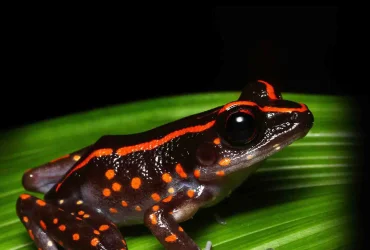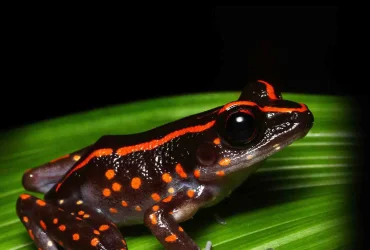Archives
 v14i2.395
v14i2.395eISSN: 1800-427X (online)
DOI:10.47605/tapro.v14i2.395
Submitted date: 22 January 2025
Accepted date: 22 June 2025
Published date: 28 November 2025
Pp. 337–342.
Venomous snake distribution in Indonesia from citizen science and museum data
S. Anita*, T. Kodama, A.E.N. Herlambang, S.T. Jusivani, M. Mumpuni, I. Sidik, A. Hamidy, R. Eprilurahman & A. Riyanto
*Corresponding author. E-mail: syah014.brin.go.id
A recent study showed that reliable information about snake demography is needed in Indonesia for mitigating snakebite risk. There are more than 300 known snake species in Indonesia, of which 57 species, or about 19% belong to the Elapidae, and 22 species (about 7%) to the Viperidae. Only a few species of snakes in Indonesia are viewed as medically important species by the World Health Organization. Most of the snakes categorized as medically important are based on their number of snakebites, resulting in high levels of morbidity, disability, or mortality in humans. Another consideration in classifying the medical importance of snakes is how frequently the species encounters large human populations. This highlights the need to better understand venomous snake diversity and distribution, particularly in areas of high human population density.
Section Editor: Patrick David
DOI:10.47605/tapro.v14i2.395
Submitted date: 22 January 2025
Accepted date: 22 June 2025
Published date: 28 November 2025
Pp. 337–342.
Venomous snake distribution in Indonesia from citizen science and museum data
S. Anita*, T. Kodama, A.E.N. Herlambang, S.T. Jusivani, M. Mumpuni, I. Sidik, A. Hamidy, R. Eprilurahman & A. Riyanto
*Corresponding author. E-mail: syah014.brin.go.id
A recent study showed that reliable information about snake demography is needed in Indonesia for mitigating snakebite risk. There are more than 300 known snake species in Indonesia, of which 57 species, or about 19% belong to the Elapidae, and 22 species (about 7%) to the Viperidae. Only a few species of snakes in Indonesia are viewed as medically important species by the World Health Organization. Most of the snakes categorized as medically important are based on their number of snakebites, resulting in high levels of morbidity, disability, or mortality in humans. Another consideration in classifying the medical importance of snakes is how frequently the species encounters large human populations. This highlights the need to better understand venomous snake diversity and distribution, particularly in areas of high human population density.
Section Editor: Patrick David
 v14i2.394
v14i2.394eISSN: 1800-427X (online)
DOI:10.47605/tapro.v14i2.394
Submitted date: 28 December 2024
Accepted date: 21 April 2025
Published date: 28 November 2025
Pp. 334–336.
White-haired Trachypithecus cristatus on Gunung Kubing, Belitung
S.S. Azyati, D.A. Rahman, Diardi, A. Yuliansyah, A. Darmawan, H.I. Maulahila & P. Rianti
*Corresponding author. E-mail: pujirianti@apps.ipb.ac.id
Leucism differs from albinism because it does not entirely inhibit melanin production but reduces pigmentation in some areas. It is often linked to low genetic diversity caused by geographic isolation and inbreeding. Leucism is a rarely reported phenomenon in primates. Reported cases in Asia include leucistic individuals of Trachypithecus obscurus (dusky leaf monkey) in Langkawi, Malaysia and Semnopithecus vetulus (purple-faced langur) in Sri Lanka. In the near kampung Bilit, Kinabatangan, Sabah, Lhota et al. (2022) report Trachypithecus cristatus (silvery langur) with a specific reduction in pigmentation, leading to uneven off-white patches appearing on different areas of the body. A notable historical report describes a silvery langur with red hair in North Borneo, suggesting that hair colour anomalies have been occurring sporadically across langur populations.
Section Editor: Vincent Nijman
DOI:10.47605/tapro.v14i2.394
Submitted date: 28 December 2024
Accepted date: 21 April 2025
Published date: 28 November 2025
Pp. 334–336.
White-haired Trachypithecus cristatus on Gunung Kubing, Belitung
S.S. Azyati, D.A. Rahman, Diardi, A. Yuliansyah, A. Darmawan, H.I. Maulahila & P. Rianti
*Corresponding author. E-mail: pujirianti@apps.ipb.ac.id
Leucism differs from albinism because it does not entirely inhibit melanin production but reduces pigmentation in some areas. It is often linked to low genetic diversity caused by geographic isolation and inbreeding. Leucism is a rarely reported phenomenon in primates. Reported cases in Asia include leucistic individuals of Trachypithecus obscurus (dusky leaf monkey) in Langkawi, Malaysia and Semnopithecus vetulus (purple-faced langur) in Sri Lanka. In the near kampung Bilit, Kinabatangan, Sabah, Lhota et al. (2022) report Trachypithecus cristatus (silvery langur) with a specific reduction in pigmentation, leading to uneven off-white patches appearing on different areas of the body. A notable historical report describes a silvery langur with red hair in North Borneo, suggesting that hair colour anomalies have been occurring sporadically across langur populations.
Section Editor: Vincent Nijman
 v14i2.393
v14i2.393eISSN: 1800-427X (online)
DOI:10.47605/tapro.v14i2.393
Submitted date: 29 December 2024
Accepted date: 21 June 2025
Published date: 28 November 2025
Pp. 332–333.
New country record of a planthopper (Pyrops viridirostris) from Bangladesh
A.I. Barkat*, S.T. Ahammad & M. Ahmed
*Corresponding author. E-mail: azizulislambarkat@gmail.com
Bangladesh is home to a vast array of floral and faunal species, showcasing amazing biodiversity, including a wide variety of insects. However, the full extent of this diversity remains largely unexplored. In particular, the planthopper diversity of the country has received minimal scientific attention. Most research on planthoppers has focused primarily on species, considered to be agricultural pests, neglecting the broader ecological roles that many of these insects play. This limited focus has left remarkable gaps in our understanding of the overall planthopper diversity of the country, which could hold untapped ecological and economic value.
Section Editor: Mick Webb
DOI:10.47605/tapro.v14i2.393
Submitted date: 29 December 2024
Accepted date: 21 June 2025
Published date: 28 November 2025
Pp. 332–333.
New country record of a planthopper (Pyrops viridirostris) from Bangladesh
A.I. Barkat*, S.T. Ahammad & M. Ahmed
*Corresponding author. E-mail: azizulislambarkat@gmail.com
Bangladesh is home to a vast array of floral and faunal species, showcasing amazing biodiversity, including a wide variety of insects. However, the full extent of this diversity remains largely unexplored. In particular, the planthopper diversity of the country has received minimal scientific attention. Most research on planthoppers has focused primarily on species, considered to be agricultural pests, neglecting the broader ecological roles that many of these insects play. This limited focus has left remarkable gaps in our understanding of the overall planthopper diversity of the country, which could hold untapped ecological and economic value.
Section Editor: Mick Webb
 v14i2.392
v14i2.392eISSN: 1800-427X (online)
DOI:10.47605/tapro.v14i2.392
Submitted date: 2 October 2024
Accepted date: 21 September 2025
Published date: 28 November 2025
Pp. 330–331.
Leopard cat (Prionailurus bengalensis) uses caves as a refuge in Maharashtra
P.R. Patil, D. Kawalkar*, S.S. Manchi, A. Dhamorikar & H. Pethe
*Corresponding author. E-mail: wawan.sujarwo@brin.go.id
The mainland leopard cat (Prionailurus bengalensis) is one of India’s 15 wild cat species, ranging widely from the Russian Far East to Singapore. Within India, it occurs across the Western and Eastern Ghats, eastern coastal hills, the Himalayas, and northeast India. Genetic and ecological analyses show that the Western Ghats population is both geographically isolated and genetically distinct from those in Northeast India and Southeast Asia. Globally, the species is classified as Least Concern, yet in India it receives the highest legal protection under Schedule I of the Wildlife (Protection) Act, 1972. Highly adaptable, the leopard cat occupies habitats ranging from tropical rainforests to human-modified landscapes such as plantations. Its distribution correlates strongly with prey abundance and local environmental conditions. Breeding patterns vary geographically—seasonal in temperate regions (late April–June in Russia) and continuous near the equator. For denning, females typically use hollow trees, dense shrubs, overhanging rocks, or large roots. Until now, there has been no record of this species using caves for birthing or shelter, making the present observation of cave use an ecologically significant finding.
Section Editor: Gennady Baryshnikov
DOI:10.47605/tapro.v14i2.392
Submitted date: 2 October 2024
Accepted date: 21 September 2025
Published date: 28 November 2025
Pp. 330–331.
Leopard cat (Prionailurus bengalensis) uses caves as a refuge in Maharashtra
P.R. Patil, D. Kawalkar*, S.S. Manchi, A. Dhamorikar & H. Pethe
*Corresponding author. E-mail: wawan.sujarwo@brin.go.id
The mainland leopard cat (Prionailurus bengalensis) is one of India’s 15 wild cat species, ranging widely from the Russian Far East to Singapore. Within India, it occurs across the Western and Eastern Ghats, eastern coastal hills, the Himalayas, and northeast India. Genetic and ecological analyses show that the Western Ghats population is both geographically isolated and genetically distinct from those in Northeast India and Southeast Asia. Globally, the species is classified as Least Concern, yet in India it receives the highest legal protection under Schedule I of the Wildlife (Protection) Act, 1972. Highly adaptable, the leopard cat occupies habitats ranging from tropical rainforests to human-modified landscapes such as plantations. Its distribution correlates strongly with prey abundance and local environmental conditions. Breeding patterns vary geographically—seasonal in temperate regions (late April–June in Russia) and continuous near the equator. For denning, females typically use hollow trees, dense shrubs, overhanging rocks, or large roots. Until now, there has been no record of this species using caves for birthing or shelter, making the present observation of cave use an ecologically significant finding.
Section Editor: Gennady Baryshnikov
 v14i2.391
v14i2.391eISSN: 1800-427X (online)
DOI:10.47605/tapro.v14i2.391
Submitted date: 10 October 2024
Accepted date: 21 July 2025
Published date: 28 November 2025
Pp. 327–329.
On the arrow-tailed flying squirrel (Hylopetes sagitta) from Mt. Ungaran, Java
M. Rahayuningsih*, P. Yuda, F. Sidiq, M.I. Muhyidhin, H. Evi, M.F. Zaka & K. Karsinah*
Corresponding author. E-mail: etak_sigid@mail.unnes.ac.id
Two species of Hylopetes, a genus of small flying squirrels native to Southeast Asia, found in the island of Java, Indonesia: (1) narrow-tailed flying squirrel (Hylopetes sagitta) and Bartel’s flying squirrel (Hylopetes bartelsi). The arrow-tailed flying squirrel (Hylopetes sagitta) (Sciuridae, Rodentia) is endemic to the islands of Java (H. s. sagitta Linnaeus, 1766) and Bangka (H. s. aurantiacus Wagner, 1841). The original specimen described by Linnaeus (1766) was named Sciurus sagitta and placed in Hylopetes by Chasen (1940), including Pteromys lepidus (Horsfield, 1824) and H. sagitta aurantiacus as a subspecies. Ellerman & Morrison-Scott (1955) recognized these species as Hylopetes lepidus which included subspecies H.l. aurantiacus and H.l. platyurus. Medway (1977) separated Hylopetes lepidus and Hylopetes sagitta into different species. Then Rasmussen & Thorington (2008) considered these species to be Hylopetes lepidus, placed H. sagitta as a synonym, and included H.l. aurantiacus and but not H.l. platyurus.
Section Editor: John Gurnell
DOI:10.47605/tapro.v14i2.391
Submitted date: 10 October 2024
Accepted date: 21 July 2025
Published date: 28 November 2025
Pp. 327–329.
On the arrow-tailed flying squirrel (Hylopetes sagitta) from Mt. Ungaran, Java
M. Rahayuningsih*, P. Yuda, F. Sidiq, M.I. Muhyidhin, H. Evi, M.F. Zaka & K. Karsinah*
Corresponding author. E-mail: etak_sigid@mail.unnes.ac.id
Two species of Hylopetes, a genus of small flying squirrels native to Southeast Asia, found in the island of Java, Indonesia: (1) narrow-tailed flying squirrel (Hylopetes sagitta) and Bartel’s flying squirrel (Hylopetes bartelsi). The arrow-tailed flying squirrel (Hylopetes sagitta) (Sciuridae, Rodentia) is endemic to the islands of Java (H. s. sagitta Linnaeus, 1766) and Bangka (H. s. aurantiacus Wagner, 1841). The original specimen described by Linnaeus (1766) was named Sciurus sagitta and placed in Hylopetes by Chasen (1940), including Pteromys lepidus (Horsfield, 1824) and H. sagitta aurantiacus as a subspecies. Ellerman & Morrison-Scott (1955) recognized these species as Hylopetes lepidus which included subspecies H.l. aurantiacus and H.l. platyurus. Medway (1977) separated Hylopetes lepidus and Hylopetes sagitta into different species. Then Rasmussen & Thorington (2008) considered these species to be Hylopetes lepidus, placed H. sagitta as a synonym, and included H.l. aurantiacus and but not H.l. platyurus.
Section Editor: John Gurnell
Hubungi Kami
The ultimate aim of the journal is to provide an effective medium for communication of the latest and best scientific information.
Copyright © 2020 Taprobanica. All Rights Reserved
Jasa Pembuatan Website by IKT




